Effects of Plant Communities on Human Physiological Recovery and Emotional Reactions: A Comparative Onsite Survey and Photo Elicitation Study
Abstract
:1. Introduction
1.1. Two Visual Experiences: Onsite Survey and Image Perception
1.2. Different Types of Landscape Perception Experience
- (1)
- How do the two perception methods affect the participants’ physical and mental recovery?
- (2)
- How does the type of plant community affect the physiological recovery and emotional reaction of the participants?
- (3)
- Are there differences in physical and mental impacts based on the gender or professional background of the participants?
2. Materials and Methods
2.1. Study Area
2.2. Experimental Design
2.2.1. Introduction to the Experiments
2.2.2. Procedure
- (a)
- Onsite surveys
- (b)
- Photo elicitation
2.2.3. Vegetation Period
2.3. Participants
2.4. Stress Task
2.5. Measurement
2.5.1. Physiological Measures
2.5.2. Psychological Measures
2.6. Data Analysis
3. Results
3.1. Impacts of Perception Methods and Plant Community Types
3.1.1. Impacts of Perception Methods
3.1.2. Impacts of Plant Community Types
3.2. Differences in the Physiological Recovery of Participants Experiencing Different Plant Community Types
3.2.1. Onsite Surveys
3.2.2. Photo Elicitation
3.3. Differences in the Emotional Reaction Recovery of Participants Experiencing Different Types of Plant Communities
3.3.1. Onsite Surveys
3.3.2. Photo Elicitation
3.4. Effects of Perception Methods and Plant Community Types on the Physiology and Psychology of Participants of Different Genders and Professional Backgrounds
3.4.1. Impacts on Participants with Different Professional Backgrounds of Perception Methods
3.4.2. Effects of Plant Community Types on Participants of Different Genders
3.4.3. Effects on Participants with Different Professional Backgrounds of Plant Community Types
4. Discussion
4.1. Effects of Two Perception Methods on Participants’ Physical and Mental Recovery
4.2. Interaction between Physiological and Emotional Reaction Recovery of Participants Experiencing Plant Communities
4.2.1. Effect of Plant Community Type on Participants’ Bodies and Minds
4.2.2. Interaction between Physiological and Mental Recovery
4.3. Impacts of Perception Method, Plant Community Type, and Gender and Professional Background of Participants on the Landscape Experience
4.4. Future Directions
5. Conclusions
Author Contributions
Funding
Institutional Review Board Statement
Informed Consent Statement
Acknowledgments
Conflicts of Interest
References
- Van den Berg, A.E.; Jorgensen, A.; Wilson, E.R. Evaluating restoration in urban green spaces: Does setting type make a difference? Landsc. Urban Plan. 2014, 127, 173–181. [Google Scholar] [CrossRef]
- Jim, C.Y.; Chen, W.Y. Perception and Attitude of Residents toward Urban Green Spaces in Guangzhou (China). Environ. Manag. 2006, 38, 338–349. [Google Scholar] [CrossRef] [PubMed]
- Sevenant, M.; Antrop, M. Landscape Representation Validity: A Comparison between On-site Observations and Photographs with Different Angles of View. Landsc. Res. 2011, 36, 363–385. [Google Scholar] [CrossRef]
- Lee, J.; Park, B.J.; Tsunetsugu, Y.; Ohira, T.; Kagawa, T.; Miyazaki, Y. Effect of forest bathing on physiological and psychological responses in young Japanese male subjects. Public Health 2011, 125, 93–100. [Google Scholar] [CrossRef] [PubMed]
- Vujcic, M.; Tomicevic-Dubljevic, J.; Zivojinovic, I.; Toskovic, O. Connection between urban green areas and visitors’ physical and mental well-being. Urban For. Urban Green. 2018, 40, 299–307. [Google Scholar] [CrossRef]
- Wei, D. Landscape Perception: Towards Landscape Semiology. World Archit. 2006, 7, 47–48. [Google Scholar]
- Shafer, E.L., Jr.; Hamilton, J.F., Jr.; Schmidt, E.A. Natural landscape preferences: A predictive model. J. Leisure Res. 1969, 1, 1–19. [Google Scholar] [CrossRef]
- Zube, E.H.; Sell, J.L.; Taylor, J.G. Landscape perception: Research, application and Theory. Landsc. Plan. 1982, 9, 1–33. [Google Scholar] [CrossRef]
- Lange, E. The limits of realism: Perceptions of virtual landscapes. Landsc. Urban Plan. 2001, 54, 163–182. [Google Scholar] [CrossRef]
- Gyllin, M.; Grahn, P. Semantic Assessments of Experienced Biodiversity from Photographs and On-Site Observations—A Comparison.Environ. Nat. Resour. Res. 2015, 5, 46–62. [Google Scholar]
- Yu, C.-P.; Lee, H.-Y.; Luo, X.-Y. The effect of virtual reality forest and urban environments on physical and mental responses. Urban For. Urban Green. 2018, 35, 106–114. [Google Scholar] [CrossRef]
- Bielinis, E.; Takayama, N.; Boiko, S.; Omelan, A.; Bielinis, L. The effect of winter forest bathing on psychological relaxation of young Polish adults. Urban For. Urban Green. 2018, 29, 276–283. [Google Scholar] [CrossRef]
- Tong, Q.I.; Wang, Y.; Wang, W. A review on visual landscape study in foreign countries. Prog. Geogr. 2013, 32, 975–983. [Google Scholar]
- Gao, T.; Liang, H.; Chen, Y.; Qiu, L. Comparisons of Landscape Preferences through Three Different Perceptual Approaches. Int. J. Environ. Res. Public Health 2019, 16, 4754. [Google Scholar] [CrossRef]
- Kroh, D.P.; Gimblett, R.H. Comparing live experience with pictures in articulating landscape preference. Landsc. Res. 1992, 17, 58–69. [Google Scholar] [CrossRef]
- Barroso, F.L.; Pinto-Correia, T.; Ramos, I.L.; Surová, D.; Menezes, H. Dealing with landscape fuzziness in user preference studies: Photo-based questionnaires in the Mediterranean context. Landsc. Urban Plan. 2012, 104, 329–342. [Google Scholar] [CrossRef]
- Pinto-Correia, T.; Barroso, F.; Surová, D.; Menezes, H. The fuzziness of Montado landscapes: Progress in assessing user preferences through photo-based surveys. Agrofor. Syst. 2011, 82, 209–224. [Google Scholar] [CrossRef]
- Stewart, T.R.; Middleton, P.; Downton, M.; Ely, D. Judgments of photographs vs. field observations in studies of perception and judgment of the visual environment. J. Environ. Psychol. 1984, 4, 283–302. [Google Scholar] [CrossRef]
- Svobodova, K.; Sklenicka, P.; Molnarova, K.; Vojar, J. Does the composition of landscape photographs affect visual preferences? The rule of the Golden Section and the position of the horizon. J. Environ. Psychol. 2014, 38, 143–152. [Google Scholar] [CrossRef]
- Valtchanov, D.; Ellard, C.G. Cognitive and affective responses to natural scenes: Effects of low level visual properties on preference, cognitive load and eye-movements. J. Environ. Psychol. 2015, 43, 184–195. [Google Scholar] [CrossRef]
- Sun, M.; Herrup, K.; Shi, B.; Hamano, Y.; Liu, C.; Goto, S. Changes in visual interaction: Viewing a Japanese garden directly, through glass or as a projected image. J. Environ. Psychol. 2018, 60, 116–121. [Google Scholar] [CrossRef]
- Jeon, J.Y.; Jo, H.I. Effects of audio-visual interactions on soundscape and landscape perception and their influence on satisfaction with the urban environment. Build. Environ. 2020, 169, 106544. [Google Scholar] [CrossRef]
- Leite, S.K.; Vendruscolo, G.S.; Renk, A.A.; Kissmann, C. Perception of farmers on landscape change in southern Brazil: Divergences and convergences related to gender and age. J. Rural Stud. 2019, 69, 11–18. [Google Scholar] [CrossRef]
- Palanica, A.; Lyons, A.; Cooper, M.; Lee, A.; Fossat, Y. A Comparison of Nature and Urban Environments on Creative Thinking across Different Levels of Reality. J. Environ. Psychol. 2019, 63, 44–51. [Google Scholar] [CrossRef]
- Browning, M.H.; Mimnaugh, K.J.; van Riper, C.J.; Laurent, H.K.; LaValle, S.M. Can simulated nature support mental health? Comparing short, single-doses of 360-degree nature videos in virtual reality with the outdoors. Front. Psychol. 2020, 10, 2667. [Google Scholar] [CrossRef]
- Lin, W.; Chen, Q.; Jiang, M.; Zhang, X.; Liu, Z.; Tao, J.; Wu, L.; Xu, S.; Kang, Y.; Zeng, Q. The effect of green space behaviour and per capita area in small urban green spaces on psychophysiological responses. Landsc. Urban Plan. 2019, 192, 103637. [Google Scholar] [CrossRef]
- Mao, G.X.; Cao, Y.B.; Lan, X.G.; He, Z.H.; Chen, Z.M.; Wang, Y.Z.; Hu, X.L.; Lv, Y.D.; Wang, G.F.; Yan, J. Therapeutic effect of forest bathing on human hypertension in the elderly. J. Cardiol. 2012, 60, 495–502. [Google Scholar] [CrossRef]
- Ulrich, R.S.; Simons, R.F.; Losito, B.D.; Fiorito, E.; Miles, M.A.; Zelson, M. Stress recovery during exposure to natural and urban environments. J. Environ. Psychol. 1991, 11, 201–230. [Google Scholar] [CrossRef]
- Tyrväinen, L.; Ojala, A.; Korpela, K.; Lanki, T.; Tsunetsugu, Y.; Kagawa, T. The influence of urban green environments on stress relief measures: A field experiment. J. Environ. Psychol. 2014, 38, 1–9. [Google Scholar] [CrossRef]
- Braithwaite, J.J.; Watson, D.G.; Jones, R.; Rowe, M. A guide for analysing electrodermal activity (EDA) & skin conductance responses (SCRs) for psychological experiments. Psychophysiology 2013, 49, 1017–1034. [Google Scholar]
- Alvarsson, J.J.; Wiens, S.; Nilsson, M.E. Stress recovery during exposure to nature sound and environmental noise. Int. J. Environ. Res. Public Health 2010, 7, 1036–1046. [Google Scholar] [CrossRef]
- Cummings, E.M.; El-Sheikh, M.; Kouros, C.D.; Keller, P.S. Children’s skin conductance reactivity as a mechanism of risk in the context of parental depressive symptoms. J. Child Psychol. Psychiatry 2007, 48, 436–445. [Google Scholar] [CrossRef] [PubMed]
- Ulrich, R.S. Biophilia, biophobia, and natural landscapes. Biophilia Hypothesis 1993, 7, 73–137. [Google Scholar]
- de Kort, Y.A.; Meijnders, A.L.; Sponselee, A.A.; IJsselsteijn, W.A. What’s wrong with virtual trees? Restoring from stress in a mediated environment. J. Environ. Psychol. 2006, 26, 309–320. [Google Scholar] [CrossRef]
- Martens, D.; Gutscher, H.; Bauer, N. Walking in “wild” and “tended” urban forests: The impact on psychological well-being. J. Environ. Psychol. 2011, 31, 36–44. [Google Scholar] [CrossRef]
- Gatersleben, B.; Andrews, M. When walking in nature is not restorative—The role of prospect and refuge. Health Place 2013, 20, 91–101. [Google Scholar] [CrossRef]
- Chiang, Y.C.; Li, D.; Jane, H.A. Wild or tended nature? The effects of landscape location and vegetation density on physical and mental responses. Landsc. Urban Plan. 2017, 167, 72–83. [Google Scholar] [CrossRef]
- Gao, T.; Qiu, L.; Hammer, M.; Gunnarsson, A. The Importance of Temporal and Spatial Vegetation Structure Information in Biotope Mapping Schemes: A Case Study in Helsingborg, Sweden. Environ. Manag. 2012, 49, 459–472. [Google Scholar] [CrossRef] [PubMed]
- Polat, A.T.; Akay, A. Relationships between the visual preferences of urban recreation area users and various landscape design elements. Urban For. Urban Green. 2015, 14, 573–582. [Google Scholar] [CrossRef]
- Aminzadeh, B.; Ghoreyshi, S. Scenic landscape quality and recreational activities in natural forest parks, Iran. Int. J. Environ. Res. 2007, 1, 5–13. [Google Scholar]
- Faccioli, M.; Font, A.R.; Figuerola, C.T. Valuing the Recreational Benefits of Wetland Adaptation to Climate Change: A Trade-off Between Species’ Abundance and Diversity. Environ. Manag. 2015, 55, 550–563. [Google Scholar] [CrossRef]
- Wang, R.; Zhao, J.; Liu, Z. Consensus in visual preferences: The effects of aesthetic quality and landscape types. Urban For. Urban Green. 2016, 20, 210–217. [Google Scholar] [CrossRef]
- Jiang, B.; Chang, C.Y.; Sullivan, W.C. A dose of nature: Tree cover, stress reduction, and gender differences. Landsc. Urban Plan. 2014, 132, 26–36. [Google Scholar] [CrossRef]
- Huang, Q.; Yang, M.; Jane, H.A.; Li, S.; Bauer, N. Trees, grass, or concrete? The effects of different types of environments on stress reduction. Landsc. Urban Plan. 2020, 193, 103654. [Google Scholar] [CrossRef]
- Markus, C.R.; Panhuysen, G.; Tuiten, A.; Koppeschaar, H.; Fekkes, D.; Peters, M.L. Does carbohydrate-rich, protein-poor food prevent a deterioration of mood and cognitive performance of stress-prone subjects when subjected to a stressful task? Appetite 1998, 31, 49–65. [Google Scholar] [CrossRef] [PubMed]
- Brown, T.C.; Richards, M.T.; Daniel, T.C.; King, D.A. Recreation participation and the validity of photo-based preference judgments. J. Leis. Res. 1989, 21, 40–60. [Google Scholar] [CrossRef]
- Tarashkar, M.; Hami, A.; Namin, F.E. The Effects of Parks’ Landscape Characteristics on Women’s Perceptual Preferences in Semi-arid environments. J. Arid Environ. 2019, 174, 104080. [Google Scholar] [CrossRef]
- Kahn, P.H., Jr. Developmental psychology and the biophilia hypothesis: Children’s affiliation with nature. Dev. Rev. 1997, 17, 1–61. [Google Scholar] [CrossRef]
- Diemer, J.; Alpers, G.W.; Peperkorn, H.M.; Shiban, Y.; Mühlberger, A. The impact of perception and presence on emotional reactions: A review of research in virtual reality. Front. Psychol. 2015, 6, 26. [Google Scholar] [CrossRef]
- Goto, S.; Shen, X.; Sun, M.; Hamano, Y.; Herrup, K. The positive effects of viewing gardens for persons with dementia. J. Alzheimer’s Dis. 2018, 66, 1705–1720. [Google Scholar] [CrossRef] [PubMed]
- Han, K.-T. Responses to Six Major Terrestrial Biomes in Terms of Scenic Beauty, Preference, and Restorativeness. Environ. Behav. 2007, 39, 529–556. [Google Scholar] [CrossRef]
- Balling, J.D.; Falk, J.H. Development of Visual Preference for Natural Environments. Environ. Behav. 1982, 14, 5–28. [Google Scholar] [CrossRef]
- Alexander, R.D. The evolution of social behavior. Annu. Rev. Ecol. Syst. 1974, 5, 325–383. [Google Scholar] [CrossRef]
- Falk, J.H.; Balling, J.D. Evolutionary Influence on Human Landscape Preference. Environ. Behav. 2010, 42, 479–493. [Google Scholar] [CrossRef]
- Appleton, J. The Experience of Landscape; Wiley: Chichester, UK, 1996. [Google Scholar]
- Wang, Y.Y.; Wang, C.; Jiang, J.H.; Qie, G.F.; Dong, J.H. Effect of VOCs from branch and leaf of Platycladus orientalis and Cinnamomum camphora on human physiology. Urban Environ. Urban Ecol 2010, 23, 30–32. [Google Scholar]
- Moscoso, C.; Matusiak, B.; Svensson, U.P.; Orleanski, K. Analysis of stereoscopic images as a new method for daylighting studies. ACM Trans. Appl. Percept. TAP 2015, 11, 1–13. [Google Scholar] [CrossRef]
- Watson, D.; Clark, L.A.; Tellegen, A. Development and validation of brief measures of positive and negative affect: The PANAS scales. J. Personal. Soc. Psychol. 1988, 54, 1063. [Google Scholar] [CrossRef]
- Wang, R.; Zhao, J.; Meitner, M.J. Urban woodland understory characteristics in relation to aesthetic and recreational preference. Urban Urban Green 2017, 24, 55–61. [Google Scholar] [CrossRef]
- Lyons, E. Demographic Correlates of Landscape Preference. Environ. Behav. 1983, 15, 487–511. [Google Scholar] [CrossRef]
- Wang, R.; Zhao, J. Demographic groups’ differences in visual preference for vegetated landscapes in urban green space. Sust. Cities Soc. 2017, 28, 350–357. [Google Scholar] [CrossRef]
- Koskela, H.; Pain, R. Revisiting fear and place: Women’s fear of attack and the built environment. Geoforum 2000, 31, 269–280. [Google Scholar] [CrossRef]
- Jorgensen, A.; Hitchmough, J.; Calvert, T. Woodland spaces and edges: Their impact on perception of safety and preference. Landsc. Urban Plan. 2002, 60, 135–150. [Google Scholar] [CrossRef]
- Zheng, B.; Zhang, Y.; Chen, J. Preference to home landscape: Wildness or neatness? Landsc. Urban Plan. 2011, 99, 1–8. [Google Scholar] [CrossRef]
- Baron, R.M.; Kenny, D.A. The moderator–mediator variable distinction in social psychological research: Conceptual, strategic, and statistical considerations. J. Personal. Soc. Psychol. 1986, 51, 1173. [Google Scholar] [CrossRef]
- Du, H.; Jiang, H.; Song, X.; Zhan, D.; Bao, Z. Assessing the visual aesthetic quality of vegetation landscape in urban green space from a visitor’s perspective. J. Urban Plan. Dev. 2016, 142, 04016007. [Google Scholar] [CrossRef]
- Zheng, B. Accounting for Preferences and Attitudes to Urban Trees and Residential Landscapes. Ph.D. Thesis, Auburn University, Auburn, AL, USA, 2009. [Google Scholar]
- Xiang, Y.; Liang, H.; Fang, X.; Chen, Y.; Xu, N.; Hu, M.; Chen, Q.; Mu, S.; Hedblom, M.; Qiu, L.; et al. The comparisons of on-site and off-site applications in surveys on perception of and preference for urban green spaces: Which approach is more reliable? Urban For. Urban Green. 2021, 58, 126961. [Google Scholar] [CrossRef]
- Ulrich, R.S. Aesthetic and affective response to natural environment. In Behavior and the Natural Environment; Springer: Boston, MA, USA, 1983; pp. 85–125. [Google Scholar]
- Russell, J.A.; Mehrabian, A. Approach-avoidance and affiliation as functions of the emotion-eliciting quality of an environment. Environ. Behav. 1978, 10, 355–387. [Google Scholar] [CrossRef]
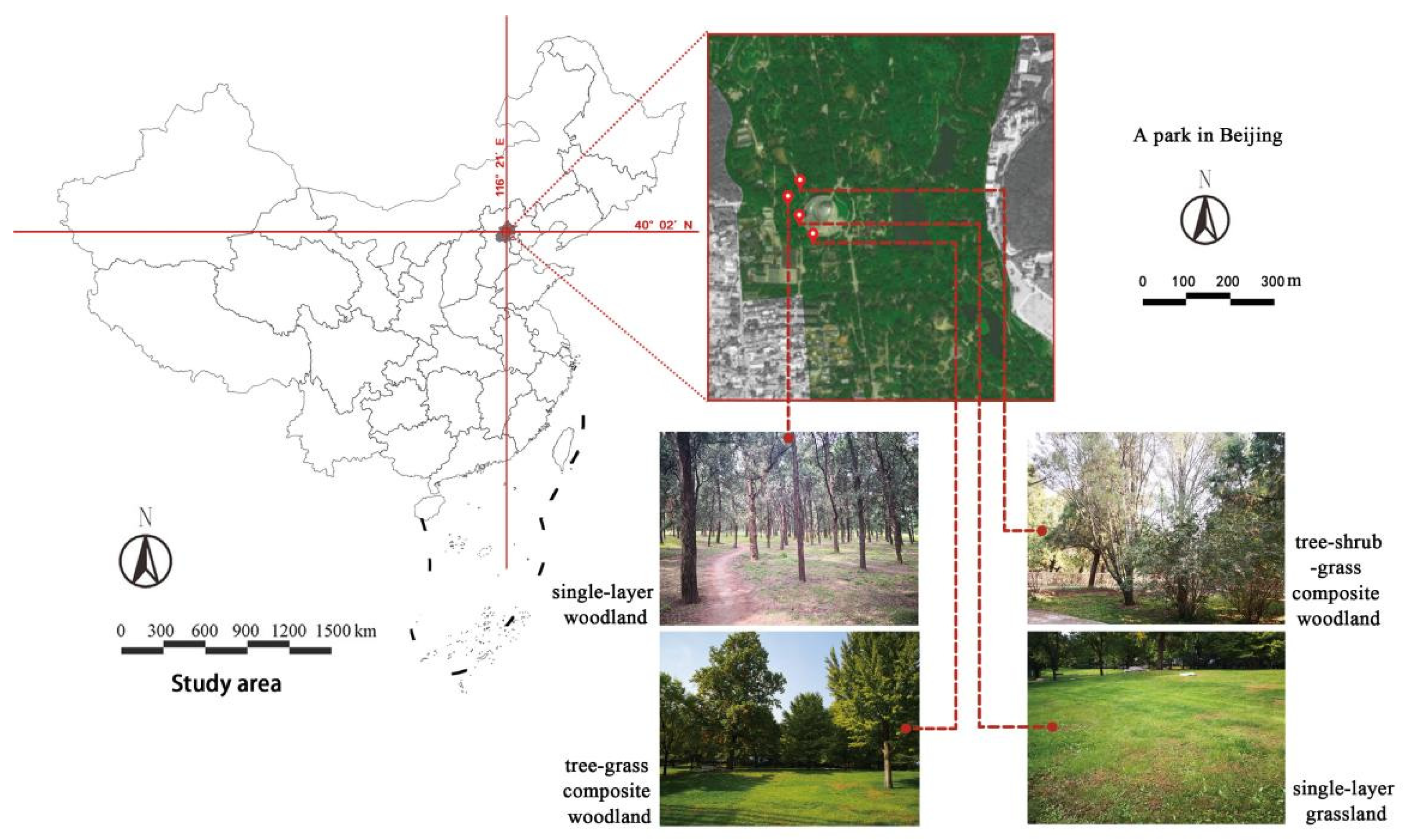

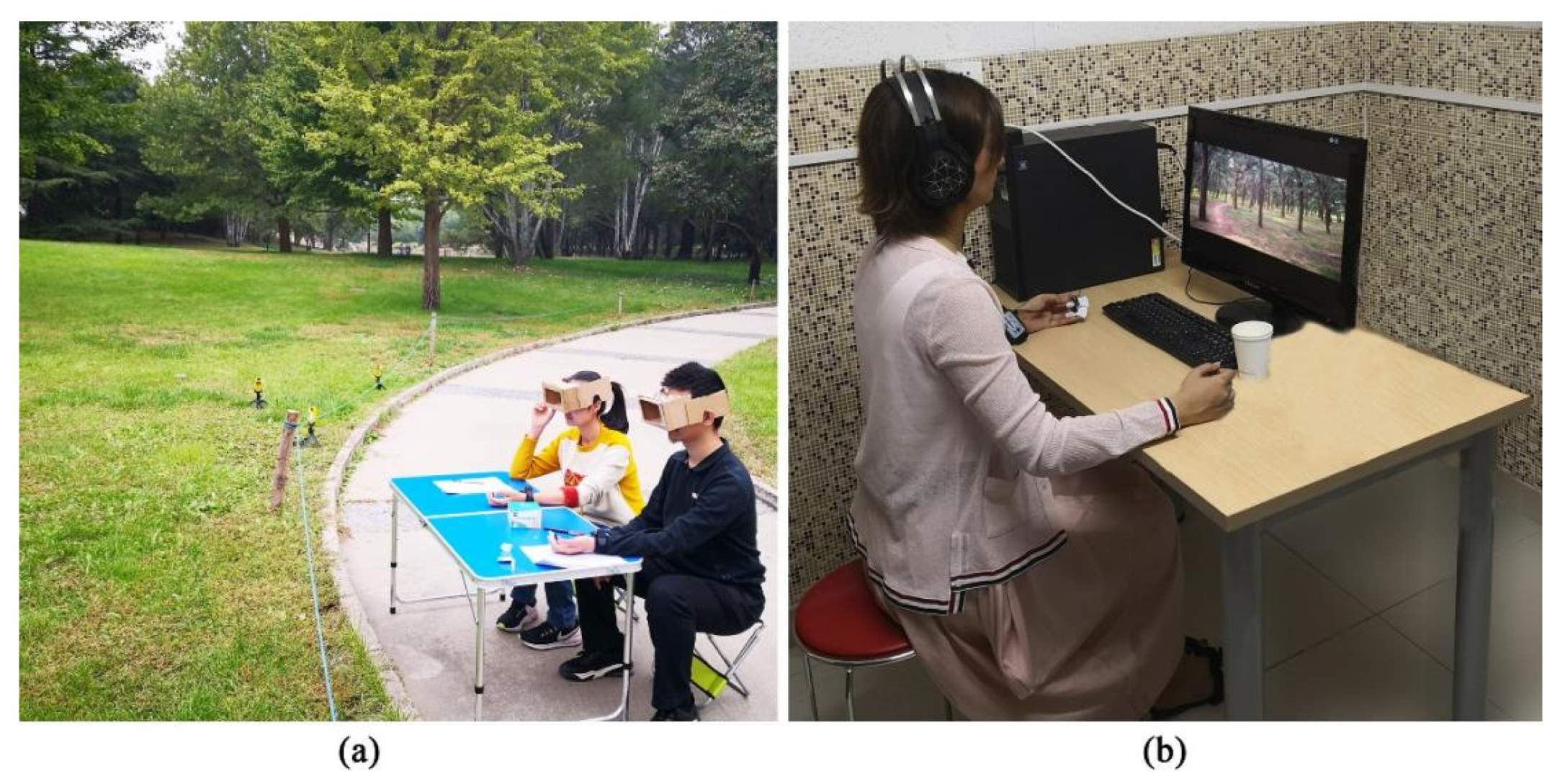

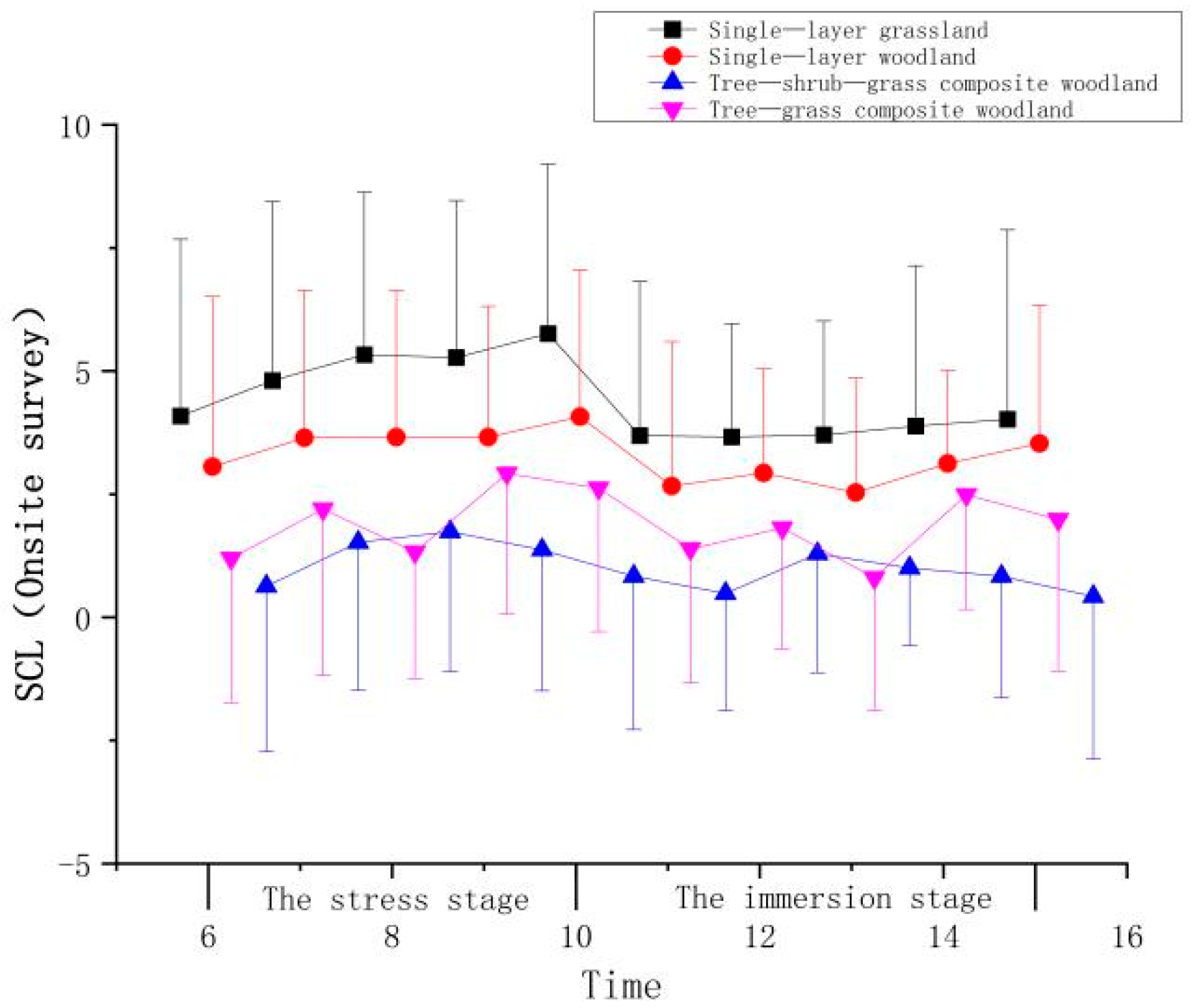
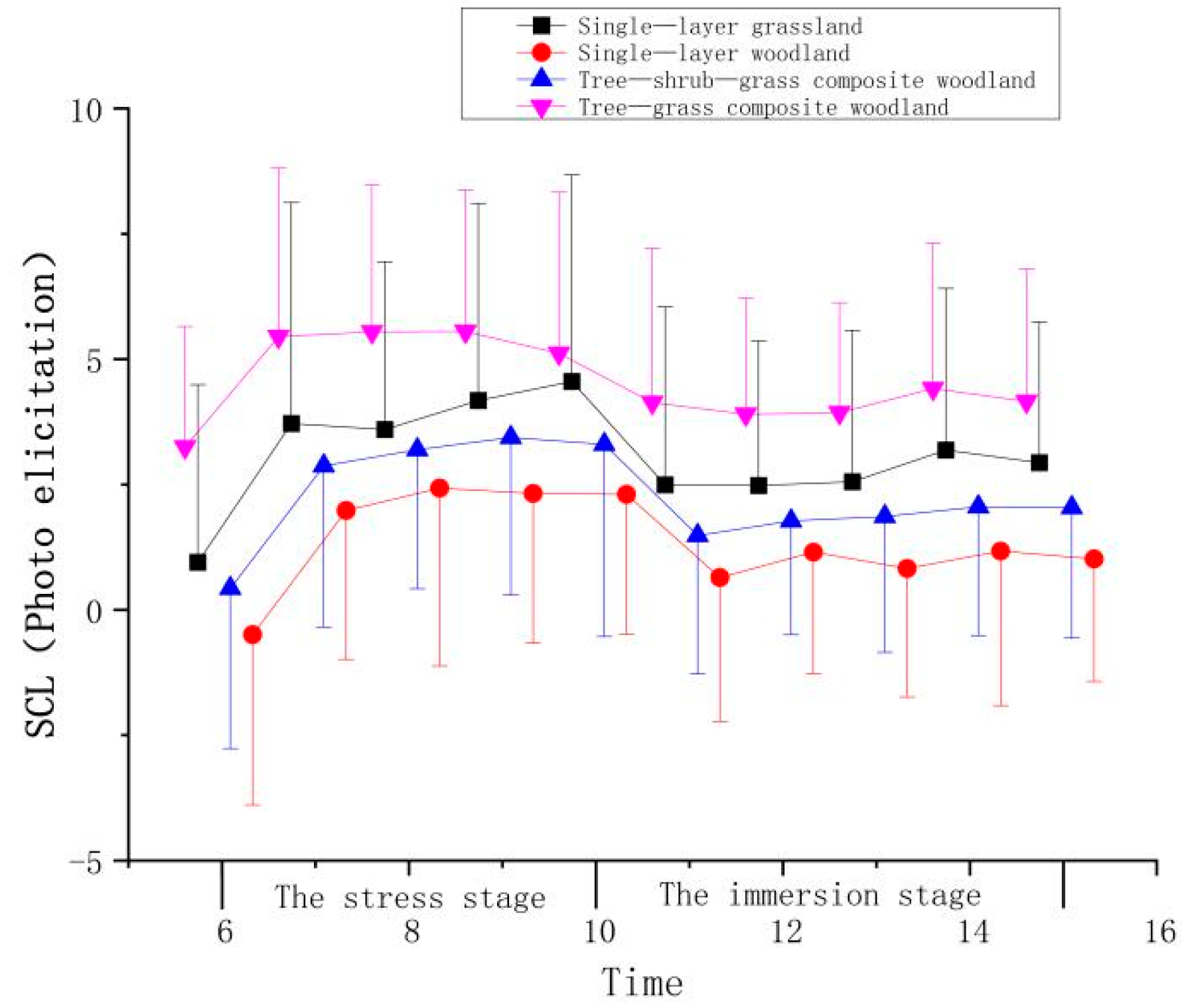
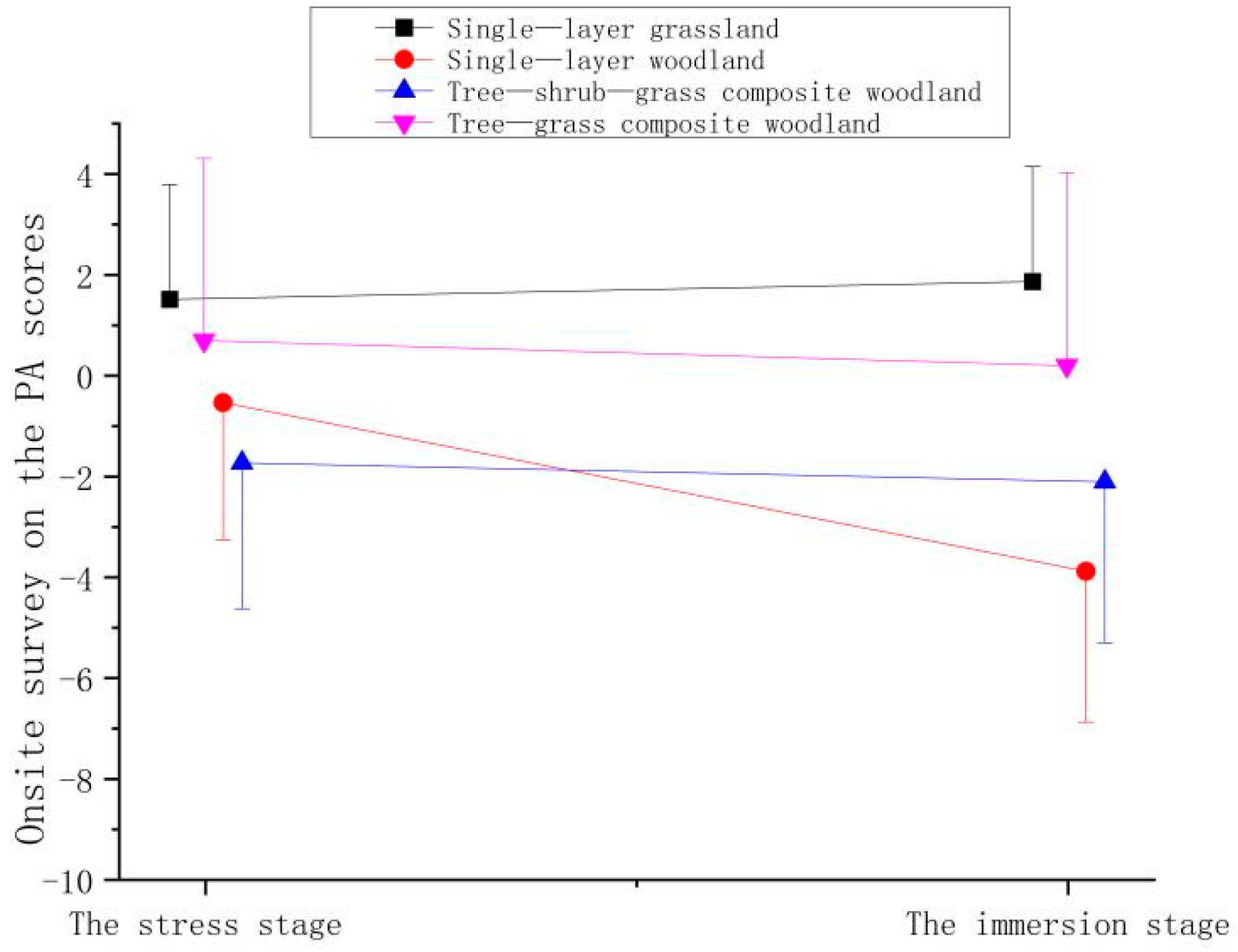
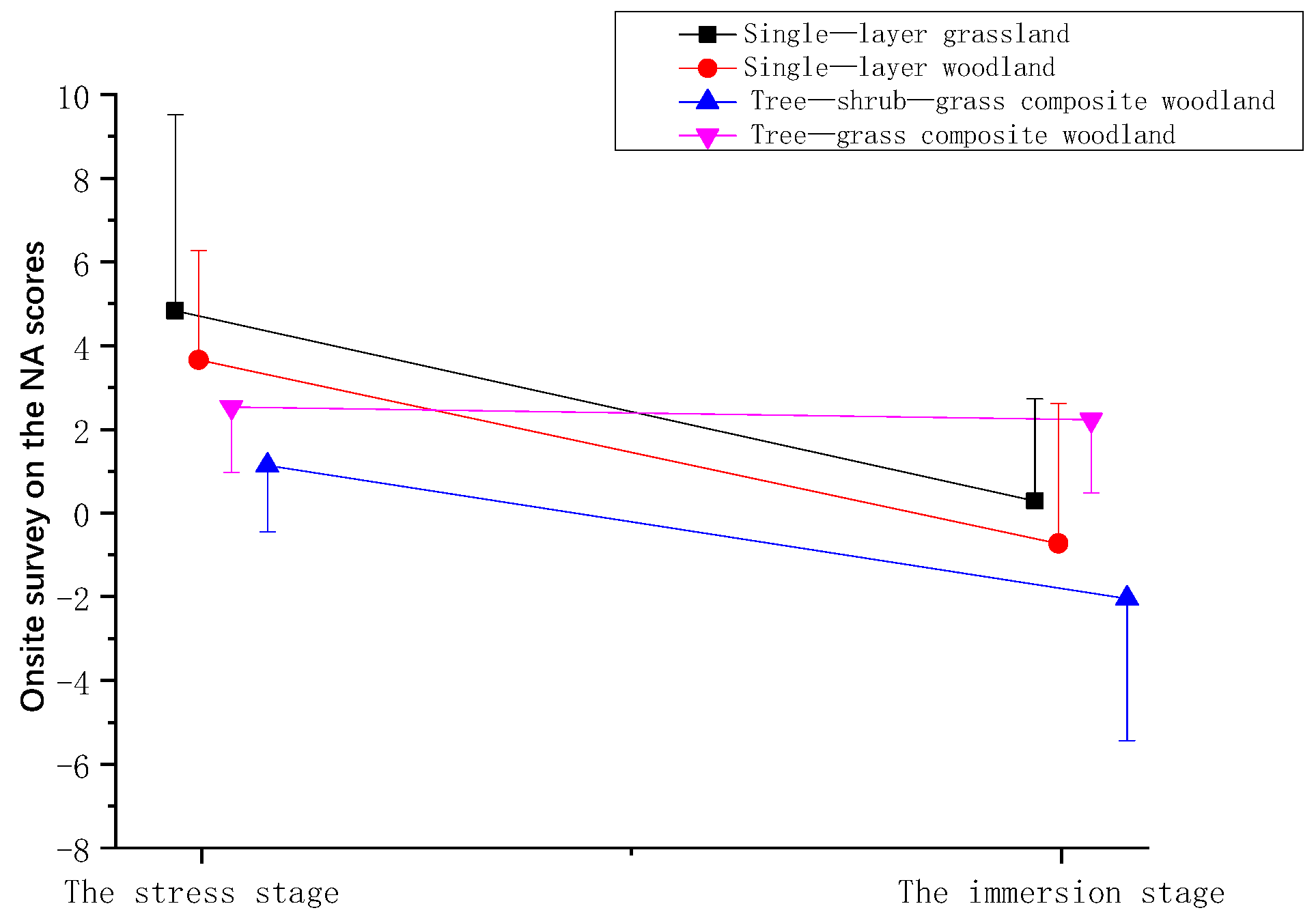

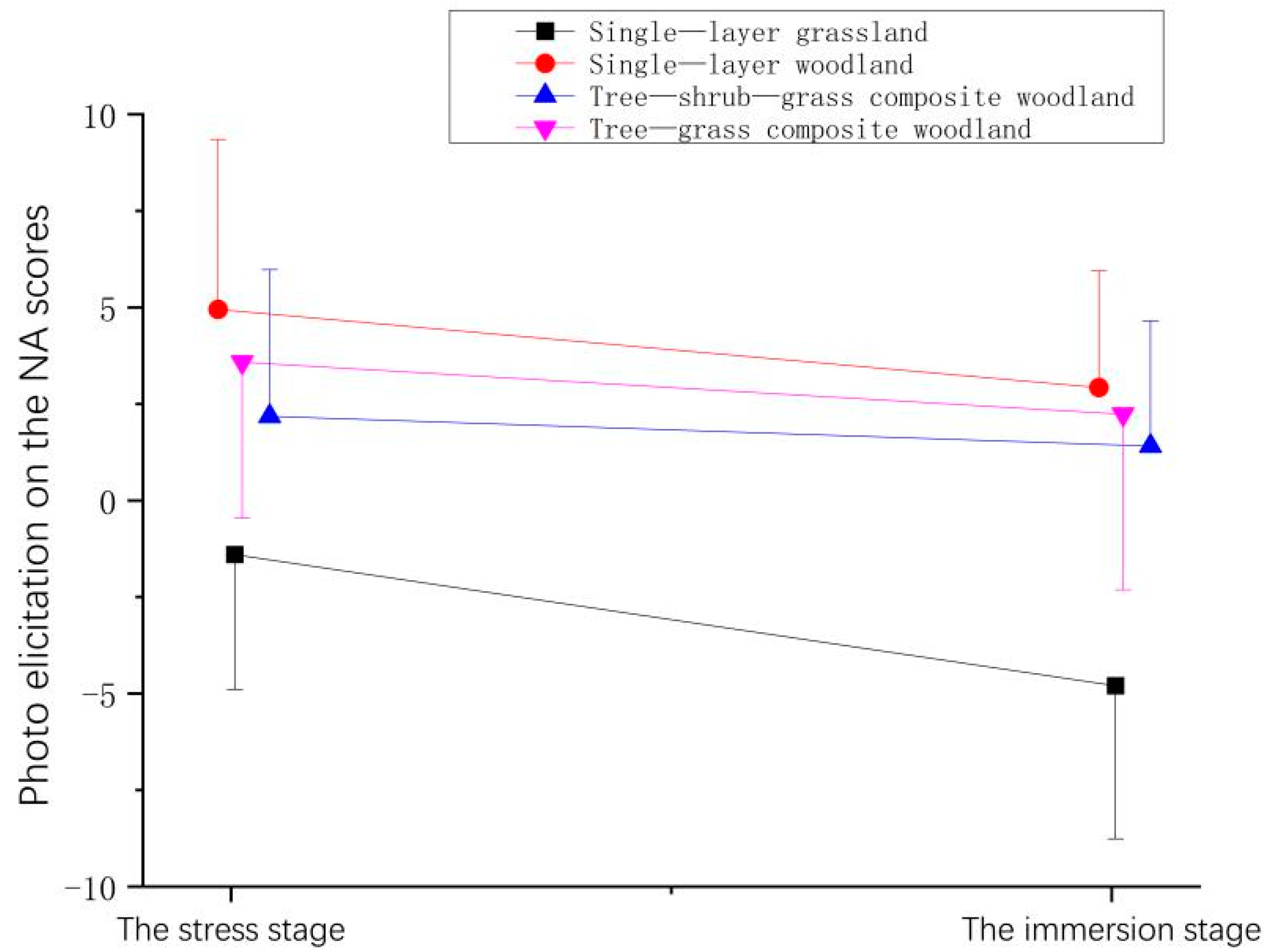
| Indicator | Onsite Survey (ΔT3) | Photo Elicitation (ΔT3) | F Value | Significance |
|---|---|---|---|---|
| SCL | −0.67 ± 0.17 | −0.77 ± 0.123 | 0.129 | 0.720 |
| PA | −0.97 ± 0.596 | −0.3 ± 0.516 | 0.741 | 0.390 |
| NA | −3.1 ± 0.507 | −1.89 ± 0.507 | 6.415 | 0.012 |
| Indicator | Single-Layer Grassland (ΔT3) | Single-Layer Woodland (ΔT3) | Tree-Shrub-Grass Composite Woodland (ΔT3) | Tree-Grass Composite Woodland (ΔT3) | F Value | Significance |
|---|---|---|---|---|---|---|
| SCL | −0.96 ± 0.23 | −0.71 ± 0.2 | −0.61 ± 0.2 | −0.62 ± 0.21 | 0.321 | 0.81 |
| PA | 1.05 ± 0.65 | −1.98 ± 1 | 0.26 ± 0.69 | −1.88 ± 0.73 | 4.924 | 0.002 |
| NA | −3.98 ± 0.77 | −3.2 ± 0.61 | −1.98 ± 0.75 | −0.83 ± 0.704 | 5.225 | 0.002 |
| Stage | Time | Mean ± (SD) | |||
|---|---|---|---|---|---|
| Single-Layer Grassland | Single-Layer Woodland | Tree–Shrub–Grass Composite Woodland | Tree–Grass Composite Woodland | ||
| The stress stage | 6 | 1.83 ± 3.59 | 1.29 ± 3.45 | 0.57 ± 3.36 | 0.73 ± 2.93 |
| 7 | 2.55 ± 3.63 | 1.88 ± 3.00 | 1.46 ± 3.06 | 1.73 ± 3.39 | |
| 8 | 3.08 ± 3.30 | 1.89 ± 2.97 | 1.68 ± 2.85 | 0.86 ± 2.57 | |
| 9 | 3.02 ± 3.18 | 1.89 ± 2.65 | 1.31 ± 2.86 | 2.45 ± 2.86 | |
| 10 | 3.51 ± 3.44 | 2.30 ± 2.97 | 0.77 ± 3.11 | 2.16 ± 2.92 | |
| The immersion stage | 11 | 1.44 ± 3.13 | 0.90 ± 2.93 | 0.42 ± 2.39 | 0.92 ± 2.73 |
| 12 | 1.41 ± 2.29 | 1.16 ± 2.12 | 1.23 ± 2.42 | 1.35 ± 2.46 | |
| 13 | 1.45 ± 2.31 | 0.77 ± 2.32 | 0.94 ± 1.58 | 0.33 ± 2.69 | |
| 14 | 1.63 ± 3.25 | 1.36 ± 1.88 | 0.77 ± 2.47 | 2.02 ± 2.34 | |
| 15 | 1.77 ± 3.84 | 1.76 ± 2.81 | 0.36 ± 3.30 | 1.52 ± 3.08 | |
| Stage | Time | Mean ± (SD) | |||
|---|---|---|---|---|---|
| Single-Layer Grassland | Single-Layer Woodland | Tree–Shrub–Grass Composite Woodland | Tree–Grass Composite Woodland | ||
| The stress stage | 6 | 0.20 ± 3.54 | −0.11 ± 3.40 | 0.01 ± 3.19 | 0.48 ± 2.40 |
| 7 | 2.97 ± 4.40 | 2.37 ± 2.97 | 2.46 ± 3.22 | 2.68 ± 3.36 | |
| 8 | 2.85 ± 3.35 | 2.81 ± 3.55 | 2.78 ± 2.78 | 2.78 ± 2.93 | |
| 9 | 3.43 ± 3.93 | 2.71 ± 2.99 | 3.03 ± 3.14 | 2.78 ± 2.83 | |
| 10 | 3.81 ± 4.12 | 2.69 ± 2.80 | 2.89 ± 3.84 | 2.35 ± 3.21 | |
| The immersion stage | 11 | 1.75 ± 3.55 | 1.03 ± 2.87 | 1.07 ± 2.77 | 1.37 ± 3.07 |
| 12 | 1.73 ± 2.88 | 1.54 ± 2.42 | 1.36 ± 2.28 | 1.13 ± 2.31 | |
| 13 | 1.81 ± 3.02 | 1.21 ± 2.57 | 1.45 ± 2.72 | 1.17 ± 2.19 | |
| 14 | 2.44 ± 3.22 | 1.56 ± 3.08 | 1.65 ± 2.57 | 1.65 ± 2.90 | |
| 15 | 2.19 ± 2.81 | 1.40 ± 2.44 | 1.63 ± 2.61 | 1.39 ± 2.64 | |
| Stage | Mean ± (SD) | |||
|---|---|---|---|---|
| Single-Layer Grassland | Single-Layer Woodland | Tree–Shrub–Grass Composite Woodland | Tree–Grass Composite Woodland | |
| The stress stage | −0.18 ± 2.27 | −0.50 ± 2.72 | −0.80 ± 2.90 | −1.18 ± 3.61 |
| The immersion stage | 0.18 ± 2.28 | −3.85 ± 2.99 | −1.18 ± 3.20 | −1.68 ± 3.83 |
| Stage | Mean ± (SD) | |||
|---|---|---|---|---|
| Single-Layer Grassland | Single-Layer Woodland | Tree–Shrub–Grass Composite Woodland | Tree–Grass Composite Woodland | |
| The stress stage | 3.13 ± 4.68 | 1.83 ± 2.62 | 0.28 ± 1.58 | 0.88 ± 1.56 |
| The immersion stage | −1.4 ± 2.45 | −2.55 ± 3.34 | −2.90 ± 3.40 | 0.58 ± 1.75 |
| Stage | Mean ± (SD) | |||
|---|---|---|---|---|
| Single-Layer Grassland | Single-Layer Woodland | Tree–Shrub–Grass Composite Woodland | Tree–Grass Composite Woodland | |
| The stress stage | −3.25 ± 5.41 | −0.08 ± 2.77 | −0.38 ± 2.62 | −1.80 ± 3.42 |
| The immersion stage | −1.50 ± 3.36 | −0.68 ± 2.72 | 0.53 ± 2.85 | −5.05 ± 3.99 |
| Stage | Mean ± (SD) | |||
|---|---|---|---|---|
| Single-Layer Grassland | Single-Layer Woodland | Tree–Shrub–Grass Composite Woodland | Tree–Grass Composite Woodland | |
| The stress stage | −1.35 ± 3.50 | 2.65 ± 4.40 | 1.65 ± 3.79 | 1.58 ± 4.04 |
| The immersion stage | −4.75 ± 3.97 | 0.63 ± 3.03 | 0.88 ± 3.24 | 0.23 ± 4.55 |
| Indicator | Onsite Survey | Photo Elicitation | F Value | Significance | ||
|---|---|---|---|---|---|---|
| Professional Group | Nonprofessional Group | Professional Group | Nonprofessional Group | |||
| SCL | −0.81 | −0.47 | −0.71 | −0.87 | 1.477 | 0.225 |
| PA | 0.97 | −3.88 | −0.35 | −0.22 | 8.978 | 0.003 |
| NA | −1.75 | −5.13 | −2.08 | −1.59 | 6.884 | 0.009 |
| Indicator | Single-Layer Grass | Single-Layer Woodland | Tree-Shrub-Grass Composition Woodland | Tree-Grass Composition Woodland | F Value | Significance | ||||
|---|---|---|---|---|---|---|---|---|---|---|
| Male | Female | Male | Female | Male | Female | Male | Female | |||
| SCL | −1.19 | −0.74 | −0.93 | −0.48 | −0.94 | −0.27 | −0.75 | −0.48 | 0.25 | 0.858 |
| PA | 1.3 | 0.8 | −3.58 | −0.38 | −0.98 | 1.5 | −1.55 | −2.2 | 0.99 | 0.398 |
| NA | −4.23 | −3.73 | −3.6 | −2.8 | −4.28 | 0.33 | −0.98 | −0.68 | 2.669 | 0.048 |
| Indicator | Single-Layer Grass | Single-Layer Woodland | Tree-Shrub-Grass Composite Woodland | Tree-Grass Composite Woodland | F Value | Significance | ||||
|---|---|---|---|---|---|---|---|---|---|---|
| Professional Background | Nonprofessional Background | Professional Background | Nonprofessional Background | Professional Background | Nonprofessional Background | Professional Background | Nonprofessional Background | |||
| SCL | −1.26 | −0.52 | −0.77 | −0.62 | −0.48 | −0.79 | −0.53 | −0.75 | 1.329 | 0.265 |
| PA | 1.42 | 0.5 | 0.71 | −6 | 1.04 | −0.91 | −1.94 | −1.78 | 3.584 | 0.014 |
| NA | −3.54 | −4.63 | −2.73 | −3.91 | −0.85 | −3.66 | −0.54 | −1.25 | 0.120 | 0.948 |
Publisher’s Note: MDPI stays neutral with regard to jurisdictional claims in published maps and institutional affiliations. |
© 2022 by the authors. Licensee MDPI, Basel, Switzerland. This article is an open access article distributed under the terms and conditions of the Creative Commons Attribution (CC BY) license (https://creativecommons.org/licenses/by/4.0/).
Share and Cite
Duan, Y.; Li, S. Effects of Plant Communities on Human Physiological Recovery and Emotional Reactions: A Comparative Onsite Survey and Photo Elicitation Study. Int. J. Environ. Res. Public Health 2022, 19, 721. https://doi.org/10.3390/ijerph19020721
Duan Y, Li S. Effects of Plant Communities on Human Physiological Recovery and Emotional Reactions: A Comparative Onsite Survey and Photo Elicitation Study. International Journal of Environmental Research and Public Health. 2022; 19(2):721. https://doi.org/10.3390/ijerph19020721
Chicago/Turabian StyleDuan, Yifan, and Shuhua Li. 2022. "Effects of Plant Communities on Human Physiological Recovery and Emotional Reactions: A Comparative Onsite Survey and Photo Elicitation Study" International Journal of Environmental Research and Public Health 19, no. 2: 721. https://doi.org/10.3390/ijerph19020721
APA StyleDuan, Y., & Li, S. (2022). Effects of Plant Communities on Human Physiological Recovery and Emotional Reactions: A Comparative Onsite Survey and Photo Elicitation Study. International Journal of Environmental Research and Public Health, 19(2), 721. https://doi.org/10.3390/ijerph19020721






